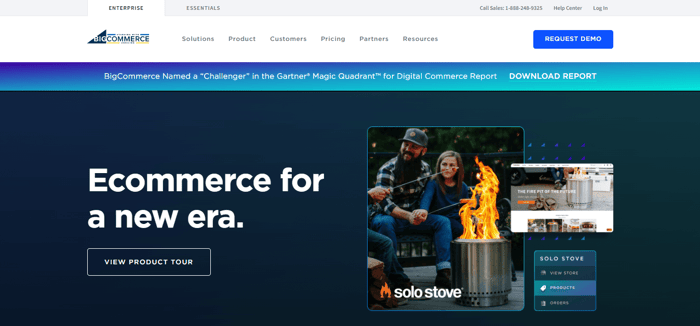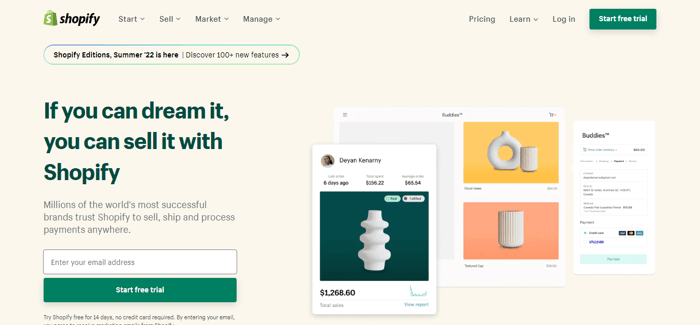BigCommerce and Shopify are very similar platforms, which means that a BigCommerce vs Shopify comparison is expected. They’re both cloud-based, SaaS, all-in-one e-commerce platforms. They’re widely known and very popular with online entrepreneurs, though BigCommerce lags behind Shopify in this department. According to the stats from SimilarWeb, in September 2024, Shopify recorded 135M total visits, while BigCommerce logged 4.5M.
However, these are just stats and aren’t very telling of how similar or dissimilar these two platforms are, so let’s discuss them in today's review.
Table of Contents
What Is the Difference Between BigCommerce and Shopify?
When it comes to features and functionality, at a glance, it looks like there’s not much that separates the two platforms. But more thorough research shows that there are some key differences between Shopify and BigCommerce.
For starters, as BigCommerce CEO Brent Bellm roughly says, the difference between his company and Shopify is that BigCommerce is better suited for large businesses, already established businesses, B2B (business-to-business) sellers, and global sellers.

Shopify, on the other hand, works better for startups. Due to the recent global changes in people’s lifestyles caused by the pandemic, entrepreneurship started massively moving online, and one of the first companies that reaped the benefits was Shopify.
It’s noteworthy that Shopify is also taking steps forward in the same direction as BigCommerce, but it’s generally considered that it hasn’t arrived there yet, even though it has such a large user base.

Despite the fact that BigCommerce began its journey as a platform that was almost identical to Shopify, in time, as its customers grew (in quantity and size), the company shifted its focus to medium-size and enterprise-level businesses. That’s how it got where it is now. This change triggered changes in other areas as well, which resulted in a platform with a unique identity that’s different from Shopify’s.
As an example of this distinctive identity, in November 2020, BigCommerce started an open-source program called Open Checkout. This is really unique since open-source code is not common in the universe of e-commerce SaaS platforms.
So, what else can we say about BigCommerce vs Shopify? What are the other differences between the two platforms and which one should you choose for your business? Let’s get into the details.
Which Is Easier to Use – Shopify or BigCommerce?
When it comes to ease of use, we’ll say right off the bat that Shopify is easier to use than BigCommerce. This is mostly because BigCommerce is more scalable and therefore has more advanced features out of the box, while Shopify is notably simpler in comparison, which is only fitting because both platforms are geared towards businesses of different sizes.
That said, BigCommerce isn’t as hard and complicated as Magento, for example, but beginners will probably need some time to get used to it and learn what they can do with it. It really does offer a more hands-on experience when it comes to editing your site and polishing the finer details.
Besides that, BigCommerce and Shopify both have comprehensible CMSs with intuitive and simply formatted dashboards that give you access to everything you need to manage your business, plus some additional helpful tools.
So, the main difference here isn’t in how efficient or clunky the UIs are but in what options are put at your disposal. In that vein, with BigCommerce, many small businesses would be paying for advanced features that they wouldn’t be able to fully make use of.
BigCommerce vs. Shopify - Pros and Cons
Here’s a short overview of the pros and cons of both platforms:
BigCommerce
Pros
Comes with many features out of the box, so you won’t have to rely on integrations as much and can cut some of the costs.
You can add up to 600 product variations.
There are no transaction fees for all plans, which is great for smaller stores.
Cons
Not entirely beginner-friendly. It’s better suited for users who have some experience with e-commerce software.
Pricing plans come with an annual sales threshold, which means that you can be upgraded to a higher pricing plan if your annual revenue exceeds the limit of your current pricing plan.
Shopify
Pros
Easy to use for any level of experience.
App store with thousands of free and paid apps to integrate with for missing features.
The themes are top-notch and well-rounded and often require minimal additional customization on your part.
Cons
Transaction fees apply unless you’re using Shopify’s native POS.
You’ll have to rely on a third-party app to make your site suitable for international visitors, like translating it into indifferent languages and showing different currencies.
Pricing Plans and Costs
BigCommerce and Shopify both offer three pricing plans. They’re very similarly priced, but they offer slightly different features, with BigCommerce having a greater range of features.
BigCommerce
Pricing Plans
BigCommerce offers three regular pricing plans:
Standard: $29.95/month
Plus: $79.95/month
Pro: $299.95/month

There’s a 10% discount if you pay in advance for a whole year, and you can kick the tires cost-free for 15 days.
There’s one more enterprise-level plan with custom pricing. The fee is determined based on the size, needs, and requirements of your business.
One common criticism of the BigCommerce pricing system is that if you hit the upper limit of annual earnings of your current plan, the platform automatically upgrades your subscription. This implies that, from that point on, you have to pay a higher fee based on the next plan on the pricing ladder.
These are the allowed annual earnings per plan starting from the lowest tier: $50K, $180K, and $400K. So, for instance, if you earned more than $50K the previous year, BigCommerce would automatically upgrade your subscription to the Plus plan.
Additional Costs
There are no transaction fees with BigCommerce, which is one of the reasons for the platform’s popularity. You can choose from a group of payment processors and use whichever you want. The company won’t take any percentage of your sales.
Another plus for BigCommerce is that it provides more tools than Shopify out of the box. This decreases the probability of its clients needing a large number of third-party apps, which means fewer additional costs.
Shopify
Pricing Plans
Shopify also offers a custom enterprise-level plan called Shopify Plus (the price goes from $2,000/month up) and three regular plans:
Basic Shopify: $29/month
Shopify: $79/month
Advanced Shopify: $299/month

In addition to this, there’s a 14-day free trial and a plan called Shopify Starter ($5/month), but with this plan, you can’t build a separate store. Instead, you get access to several Shopify features that you can use alongside your account on another platform or in combination with your social media sales and marketing campaigns.
Additional Costs
The Shopify pricing plans are similar to what we saw at BigCommerce. However, with Shopify, you may end up spending a lot more money compared to BigCommerce.
First, it’s because of the existing transaction fees. When clients use the Shopify payment gateway called Shopify Payments, they don’t pay transaction fees, but Shopify Payments is not available everywhere in the world, unfortunately. This means you'll be charged transaction fees if you’re in a country where you can’t use Shopify's payment gateway.
So where is Shopify Payments available?
Shopify Payments was introduced in 2013, but at that time, it was only available for use in a small select group of countries. Over time, the list has expanded. At this moment, it includes the following countries: Australia, Austria, Belgium, Canada, Denmark, Germany, Hong Kong, Ireland, Italy, Japan, Netherlands, New Zealand, Singapore, Spain, Sweden, the United Kingdom, the United States, and Puerto Rico.
The second reason Shopify may end up costing more is that the credit and debit card fees are a tiny bit higher at Shopify.
Third, the platform offers a smaller out-of-the-box feature set, so you’ll probably have to pay for more add-ons, dramatically increasing your monthly spending.
Fourth, despite the fact that Shopify says that it handles 133 different currencies, underneath the hood, the payment processes are executed in your primary currency, so you actually pay conversion fees.
BigCommerce vs. Shopify – A Comparison of Notable Features
Both platforms offer a variety of useful tools and features, but the general consensus is that in this regard, BigCommerce has the upper hand. BigCommerce has more built-in enterprise functionality, and it’s more flexible. It allows its clients to configure more aspects of their e-commerce store without paying additional costs.
On the other hand, Shopify was created as a simple e-commerce solution. In contrast, more built-in features usually mean more complexity, which is what we see in BigCommerce. So, what Shopify lacks in built-in functionality, compared to BigCommerce, it more than makes up for in ease of use. Also, this is in harmony with the platform being mainly, although not exclusively, geared towards startups and small businesses.
So, when you’re deciding which one to choose, feature-wise, choosing between BigCommerce and Shopify means choosing between more features and less simplicity vs. fewer features and more simplicity.
Now let’s have a look at several features on both sides.
BigCommerce
Number of Staff Accounts
BigCommerce is great for bigger teams since it doesn’t put a limit on the number of staff accounts as Shopify does. This is one of the most notable differences between the platforms and one of the biggest pluses for BigCommerce, which explains why it’s better suited for large businesses.
Types of Discounts
BigCommerce gives you the possibility to offer many different types of discounts to your clients, and it has a host of product configuration options. For comparison, Shopify lets you configure only three product options out of the box.
SEO Tools
BigCommerce provides you with excellent SEO tools, with the most noteworthy one being the ability to customize the URLs, making them more SEO-friendly.
Blogging Functionality
Both platforms offer blogging tools, although very elementary ones. You can do the basics, like adding images, dates, and authors to your posts and do some basic SEO optimization, but nothing beyond that, which is why many seek third-party blogging integrations. However, BigCommerce integrates better with WordPress, and your blog won’t be hosted on a subdomain.
Image Manager
BigCommerce has built-in software called Akamai Image Manager that automatically optimizes the images in your store for quicker page load time, which is really smart. Having an online store relies heavily on product images, and having them load faster increases the chances of your customers browsing your store for longer.
Fast Loading Speed
BigCommerce allows a high number of requests per second on its APIs – more precisely 400 per second – which means better speed on your store’s side when you need to synchronize larger volumes of items. For comparison, Shopify lets you have four requests per second. That’s a big difference.
Shopify
Collections Instead of Categories
Shopify uses collections instead of the traditional hierarchical category/subcategory model for grouping products. This makes things easier for your clients when they are browsing your products. Although some shop owners find the collections a bit confusing, probably because the majority of users are accustomed to the notion of categories, this can be a very helpful feature.
In a nutshell, it gives you flexibility by allowing you to create numerous groups of items and place them wherever you want. You can create manual or automated collections, which is especially helpful if you have a very large inventory.
For example, you can create seasonal collections for Christmas or items that are in a certain color. Or you can even create a special collection of products that are always shown on your home page without necessarily belonging to one category.
The possibilities are endless, and for more info, you can read about Shopify collections here.
Abandoned Cart Recovery
Abandoned cart recovery is an essential e-commerce feature, and on Shopify, it’s available with each (even with the cheapest!) Shopify plan. This is not the case with BigCommerce, where abandoned cart recovery is missing from the Standard plan, which is the most basic one.
Native POS
Shopify POS (point-of-sale) Lite is another important feature included in every pricing plan. This is very good news for entrepreneurs who sell online but own a physical store too. You don’t need to do anything special to activate the Shopify POS. You just need to get the necessary hardware, and you’ll be able to accept payments via your online and brick-and-mortar stores. Also, it enables you to sync and manage your stock lists and orders from one account.
Dropshipping
Shopify provides one of the best dropshipping functionalities on the market. If this is the business model that you favor, Shopify is definitely your friend.
Popularity
This isn’t a technical feature per se, but it’s worth noting that Shopify is probably the most popular e-commerce platform, which naturally attracts more developers. With a large developer community, chances are that you’ll always have access to new cutting-edge technology, that is, state-of-the-art apps on the Shopify app store.
Pioneering and Forward-Looking
Another non-technical feature, but more like a quality that’s also worth pointing out: Shopify has always been creative, inventive, and visionary. Over all these years of its existence, it democratized and revolutionized the ways people do e-commerce.
Since artificial intelligence is one of the hottest topics of this century, and Shopify has already invested in an AI and robotics company, we can expect this tradition to continue in the future.
Design and Customization
BigCommerce
Templates
There are many templates in the BigCommerce theme store to choose from, and they all look pretty nice. The designs aren’t repetitive, and you can find many different layouts that will work for different types of businesses. It goes without saying that they’re all responsive and customizable.

Some of the templates are free (12 to be exact), and others are paid. The prices for the paid ones range between $150 and $350.
The themes are well designed, so you don’t necessarily need to intervene and tweak anything before launching your store. But if you want your store to have a more personal touch and look more in line with your brand, then BigCommerce provides a page builder where you can customize your storefront.
Page Builder
The BigCommerce page builder is a visual drag-and-drop editor. It doesn’t require coding skills or advanced technical knowledge to use it. The changes you can make with it are pretty standard. You can play around with text, colors, navigation, headers, footers, buttons, etc.
The BigCommerce page builder has a simple and straightforward UI, and we’d say it’s pretty intuitive. You’ll find everything you need to customize your store, and if you have some experience with page builders, it shouldn’t take you long to find your way around it. This is what it looks like:

In addition to this, if you know your way around HTML, CSS, and JavaScript code, BigCommerce enables you to do advanced customization.
All in all, what BigCommerce offers in terms of design and customization is not bad. You get to build a really nice store, and if you know code, you can tweak it however you like. However, its page builder is nothing special either. It’s basically the standard stuff you’ll find anywhere else, if we’re being objective.
Shopify
Templates
The same that we saw at BigCommerce applies here. There’s not a significant difference, although it looks like the majority of reviewers are of the opinion that, regarding design and aesthetics, Shopify has a slight edge over BigCommerce.

Shopify offers nine free templates and over 80 paid, with the prices being very close to BigCommerce’s – from $180 to $350. The same applies to Shopify’s themes – they’re responsive, functional, and very good-looking.
Ease of use and convenience are among the staples of the Shopify philosophy; the templates are designed so that customers can use them right off the bat.
Page Editor
Of course, many Shopify customers would rather customize their storefronts before going live. Shopify allows you to do that via its page editor. It’s the same type of drag-and-drop editor found at BigCommerce.
Similarly, the editor is convenient, straightforward, and very easy to use. This is the Shopify page editor in action:

Generally speaking, drag-and-drop editors are a good option because they’re pretty simple to use. The trade-off is that they’re not super flexible, so they only offer a limited set of customization options. That’s why, just like BigCommerce, Shopify also leaves room for advanced customization through coding.
Integrations
BigCommerce
BigCommerce has over 1,000 apps in its app store, which isn’t as much as Shopify has, but it’s not too shabby either, considering that BigCommerce already comes with so many built-in features. You have access to all the major and some lesser-known apps for analytics, marketing, payments, shipping, and more, found in 21 categories. Not bad at all.

And if the categories don’t do it for you, there are app collections where different apps are grouped according to their purpose, so if you’re looking for something specific, you can find it there.
Shopify
It’s amazing how many extension-of-functionality options you get with the Shopify app store. There are more than 6,000 apps listed there in 12 categories. This is definitely one of the things that separates Shopify from its rivals. In essence, any company that means something in the e-commerce market has its app on the Shopify app store. There’s an app for anything you’d ever need.

There are free and paid apps grouped in various categories, depending on what they were developed for. There are apps for store design, marketing, sales and conversion, ordering and shipping, inventory management, security, and more.
If you plan on adding a bunch more functionalities to your store through third-party integrations, you can’t do better than with Shopify. Let’s take blogging as an example. I mentioned that Shopify offers a blogging option, but, just like BigCommerce, it’s very basic and underwhelming.
Well, thanks to the Shopify app store, you’ll have the chance to add the unparalleled blogging tool DropInBlog. Why go back to the past with WordPress when you can go back to the future with this powerful blogging option?
Customer Care and Resources
When it comes to customer care and resources, both BigCommerce and Shopify score high. With 24/7 phone, live chat, and email support available for all plans, they both make sure that their customers are covered on all fronts.
Both platforms have superb help centers, community forums, and video tutorials geared towards beginners. BigCommerce even gives its customers a space to share their ideas about how to improve the product or service.
What we also like about their approach to customer care is that they have learning hubs for those looking to hone their skills. BigCommerce University offers courses for both business users and technical users, while on Shopify Learn, you can find courses mostly on business and marketing.
All in all, both platforms are intent on keeping the relationship with their customers tight and have taken all measures to do so.
FAQs
Is BigCommerce good for beginners?
While BigCommerce isn’t necessarily hard to use, it can be challenging for e-commerce beginners due to the fact that it offers so many features. Beginners always have a lot to learn, and when it comes to e-commerce, BigCommerce just doesn’t provide that simplicity where they can understand how certain e-commerce features work and learn to use them to their advantage.
In this case, Shopify is a much better alternative for beginners due to its simplicity and efficacy.
Is Shopify worth it for small businesses?
Yes, Shopify is definitely worth it for small businesses. Even though it’s not among the cheapest in its category – like Square, Wix, or Squarespace, for example – it’s one of the more affordable business software solutions on the market. Even with its cheapest plan, you have enough features to launch, run, and manage a successful business until you grow enough to upgrade your plan and obtain more features.
The only downside is all the additional costs, like transaction fees and payment processor fees, the latter of which you can avoid if you use the Shopify POS. Still, Shopify remains a well-rounded platform and an overall great solution for small businesses.
Is BigCommerce good for small businesses?
BigCommerce can technically be used by businesses of all sizes, but when it comes to small businesses, it’s not ideal. It certainly wouldn’t be criminal if you use BigCommerce to manage your small business, but where the problem generally lies is that BigCommerce comes with many features out of the box that not all small businesses would benefit from. Its features are intricate, and unless your business sells a lot of products, you’ll hardly need their full scope until you scale up.
If you’re curious, you can check out these case studies on BigCommerce’s website and see how other businesses fare with it.
Is Shopify suitable for enterprise-sized businesses?
Shopify wasn’t inherently built for enterprises, which is why they have developed the Shopify Plus plan. The challenging part of powering enterprise businesses is that they require an infrastructure capable of performing more complex operations (more traffic, larger inventory, more employees, bigger competition) and providing stronger security and support.
So, the answer to this question lies somewhere in the middle – it really depends on your business and on what you need. Shopify has made the enterprise plan entirely customizable, but it doesn’t mean you won’t have to rely on integrations about some functionalities anymore. While this might work for some – Tesla and The New York Times use Shopify Plus – for others, BigCommerce may be a better fit with its out-of-the-box features.
Over and Out
There’s a reason why Shopify is so popular and considered to be an e-commerce giant. There’s also a reason why BigCommerce is considered to be its biggest rival, although, as we saw at the beginning, the company has been building a distinctive identity that has helped it to carve out a niche for itself.
Generally speaking, you can’t go wrong with either one of these platforms. However, generalities are not always useful. A good business choice comes from going beyond mere generality, and I hope that this BigCommerce vs Shopify comparison helped you get exactly there.




